C
Facilities at NIST’S Boulder Campus
OVERVIEW OF NIST BOULDER FACILITIES
The National Institute of Standards and Technology (NIST) manages the Department of Commerce (DOC) Laboratories in Boulder, Colorado, a 206-acre campus where research is accomplished not only by NIST but also by the National Oceanic and Atmospheric Administration (NOAA) and the National Telecommunications and Information Administration (NTIA). The Boulder Master Plan states the campus has 29 buildings and 5 unoccupied structures totaling 1,254,174 gross square feet (GSF).
Of the buildings on the DOC Boulder Laboratories campus, NIST owns and maintains 28 buildings and structures totaling over 916,000 GSF. Five buildings, approximately one third of the existing square footage (over 300,000 GSF), was built in 1951-1957, as part of the original campus construction. Nearly 404,000 GSF (44 percent) of facilities were built in the last 20 years. The only structure determined eligible for the National Register of Historic Places is a portion of Building 1.
The development of the campus is noted in Figure C-1 below. Buildings 33 and 34 are owned by the General Services Administration (GSA) and utilized by NOAA. The team did not address GSA managed facilities in its review.
NIST’S CURRENT AND PAST PROJECTS TO MODERNIZE LABORATORY FACILITIES
The Boulder campus is 11 years older than its sister campus in Gaithersburg. In 1991, a Capital Improvement Facilities Plan recommended:
- The construction of a central utility plant (CUP)
- The renovation of Building 1’s Wings 3, 4, 5, and 6 to create laboratories suitable to meeting the demands of modern research
- The construction of Building 81, the Building 1 Extension, later renamed to the Precision Measurement Laboratory (and currently called the Katherine Gebbie Laboratory), to relocate laboratories from Building 1 to enable renovation of the wings
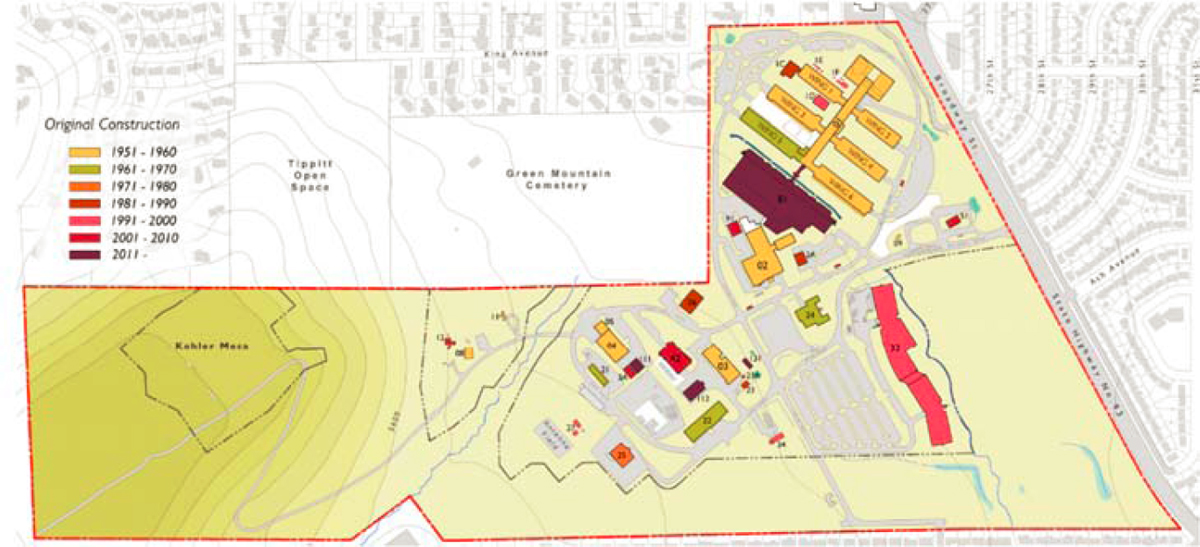
SOURCE: Office of Facilities and Property Management, NIST.
The 1991 Capital Improvement Facilities Plan led to the construction of the central utilities plant, but further construction was stalled. In 2006, the NIST-Boulder Facilities Review Team released a Report1 on NIST-Boulder Laboratory Facilities (January 31, 2006) that asserted that the 1991 plan was rendered outdated by delays. Instead, this document recommended the construction of a new high-performance laboratory that could allow immediate improvement of laboratory physical condition and functionality while providing swing space for Building 1 renovation. This document also defined various laboratory performance levels as well as estimates of space needs based on program requirements. The proposed standards are shown below in Table C-1.
Progress to Date to Close the Gap
The CUP was built in 2006 and expanded in 2011. As part of this project, a large underground tunnel was run the length of the campus so that power, chilled water, and compressed air could be maintained and serviced in a controlled environment. The CUP facility and the tunnel are in excellent condition and well maintained.
The Building 1 renovation project proceeded first with the construction of Building 81 and then with the renovation of Wings 3 and 6. The renovation of Wings 4 and 5 have been fully funded. NIST also had the opportunity to renovate Building 3 for a new mission requirement associated with the standup of the Communications Technology Laboratory (CTL).
The 123 laboratories on the Boulder campus which exceed the L1 standard are limited to those funded within the past 14 years. The following information in Table C-2 was provided by the Office of Facilities and Property Management (OFPM) about progress on Master Plan projects.2
Unrenovated Laboratories
Building 1 and Building 2 are part of the initial construction of the campus; Building 2 was built in 1951 and Building 1 was constructed over several years beginning with Wings 1 and 2 in 1954 and completed with wing 6 in 1962 (NIST 2017). Building 24 was constructed in 1967 (NIST 2017); the building’s condition is so deteriorated
TABLE C-1 Laboratory Performance Levels
| Description | Code | Estimated Amount Required (NASF) | Temperature Control (°C) | Humidity Control % | Air Filtration | Vibration Control (μma/sec) |
|---|---|---|---|---|---|---|
| General Lab Level 1 | L1 | 39,000 | +/– 2 | NA | M6.5 | Insensitive |
| General Lab Level 2 | L2 | 12,500 | +/– 1 | +/– 20 | M6.5 | 12.5 |
| General Lab Level 3 | L3 | 78,700 | +/– 0.5 | +/– 20 | M5.5 | < 12.5 |
| High Performance Lab | L4 | 25,400 | +/– 0.5; +/– 0.25 in an enclosure | +/– 10 | M5.5 | 6 |
| Instrument Lab | L5 | 22,600 (combined for both levels) | +/– 0.25 | +/– 5 | M3.5 | 3 |
| Precision Metrology Lab | L6 | +/– 0.1 | +/– 5 | M3.5 | < 3 |
a μm, millionth meter.
SOURCE: NIST Boulder Facilities Review Team, 2006.
___________________
1 NIST-Boulder Facilities Review Team. 2006. Report on NIST-Boulder Laboratory Facilities.
2 Data provided by NIST with regard to CRF/SCMMR Funding 2001-2021.
that NIST intends to cease to invest in the building, instead they plan to replace the facility in whole and demolish it. Building 2A is a modular building that was constructed as a temporary solution to the lack of research space but has been in use as laboratory space for over three decades. These 198 laboratories (see Table C-3) in unrenovated facilities represent 62 percent of the 317 laboratories located in NIST facilities in Boulder.
EFFECTIVE RESEARCH IS PEFORMED IN RECENTLY MODERNIZED LABORATORY FACILITIES
In 2012, NIST dedicated the Precision Measurement Laboratory (Building 81, later renamed the Gebbie Laboratory in 2015). Of the $121 million design and construction cost, $87.4 million was provided by the American Recovery and Reinvestment Act (ARRA) and the remainder was funded with CRF funds. This project constructed a 286,674 GSF building that includes 70 advanced research and measurement laboratories (44,400 GSF) and a “class 100” clean room (18,800 GSF) for micro- and nanofabrication.3 The laboratory specifications include temperature control of within 0.5 degrees F (0.25 degrees C), humidity control of within 5 percent, high-efficiency particulate air (HEPA)-filtered air intake, and vibration control limiting velocity amplitude to 3 micrometers per second at 20 Hertz (Hz) to 100 Hz.
This new laboratory space supported many technical successes. The committee viewed several such cases.
Enabling Measurements for a $10 Trillion Market Sector Tabletop X-Ray Spectroscopy
(Building 81, Room 1D124)
High signal-to-noise X-ray spectrometry is usually done using free electron lasers that cost $1 billion, and there are no commercial tools for X-ray absorption and emission spectroscopy with picosecond time resolution. In this laboratory, a tabletop X-ray system using conventional lasers has been demonstrated with picosecond resolution. The instrument uses a two-beam pump probe configuration and performs experimental runs of 100 hours or longer. This experiment could not be performed in another building on the NIST-Boulder campus, as the exceptional temperature and vibration control provided in this new laboratory Building is absolutely required.
Increasing the accessibility of X-ray spectroscopy will enable research that can have substantial economic impact. One application of X-ray spectroscopy is to improve the understanding of chemical catalysis processes. While the market for catalysts is about $35 billion worldwide, these create over $10 trillion in value; over 80 percent of all manufactured products, and approximately 90 percent of all industrial chemicals, use catalysts within the manufacturing process (Lynch 2020).
Impact: One example application of the novel measurement, improving the efficacy of catalysts, promises substantial return since the processes underpin $10 trillion of economic activity.
New Understanding of Nanostructures for Electronic, Photonics, and Quantum Science
Atom Probe (Building 81, Room 1C121)
Atom probes are advanced tools that allow an atom-by-atom analysis of a materials structure and composition. NIST has advanced commercial atom probe techniques with a new UV-laser excitation probe that increases the range of atoms that can be detected, an improvement that increases the utility of these instruments. Because this measurement brings highly focused laser beams into a floor-mounted vacuum and detection system, vibration control is paramount. Specialized slab engineering specified during the Building 81 planning provides this level of control (and is only found in this building).
___________________
3 OFPM. “NIST Facilities Overview.” April 11, 2012.
TABLE C-2 Master Plan Renovation Projects
| B81 - PML | B1 Wings 3 and 6 | B1 Wings 4 and 5 | B3 - CTL | |
|---|---|---|---|---|
| Method | New Construction | Renovation | Renovation | Renovation |
| Year(s) funded | FY 2008-2011 | FY 2011-2016 | FY 2020-In Progress | FY 2015-2018 |
| Year completed | FY 2012 | FY 2016 | n/a | FY 2019 |
| Total construction of research facilities funding | $33.6 million | $57.4 million | $104.9 million | $16.8 million |
| Total scientific and technical research services funding | $3.0 million | |||
| American Recovery and Reinvestment Act funding | $87.4 million | |||
| Total initial cost | $121.0 million | $57.4 million | $19.8 million | |
| Recurring increase in funding for operations and maintenance | None | None | None | None |
| Actual total operations and maintenance cost (FY 2021) | $4.669 million | $1.057 million | $1.659 million | $0.805 million |
| GSF added by project | 286,674 GSF | 5,829 GSF | 14,707 GSF | 24,429 GSF |
| GSF renovated by project | 53,505 GSF | 86,615 GSF | 27,449 GSF | |
| GSF removed from inventory | N/A | N/A | N/A | N/A |
| Deferred maintenance reduction by project | N/A | (not provided) | In progress | $2.16 million |
| Current replacement value of facility | $163.6 million | $47.8 million | $81.6 million | $16.5 million |
| Current project backlog | $1.775 million | 0 | $0.424 million | |
| Current facility condition index | 98.91 | 69.04a | 69.04a | 97.44 |
| Number of laboratories and Rating | 70 at L4/L5 | 20 at L2/L3 | 26 at L3 | 3/L2 |
| Number of researchers | 87 | In progress | 70 | |
| Laboratory controls | ||||
| Temperature control | ||||
| Humidity control | L4/L5 | L2 (L3 Capable) | ||
| Air filtration | ||||
| Vibration control | L5 | L4 | ||
| L4/L5 | L2 (L3 Capable) | |||
| L5 | N/A |
a The FCI is computed for the entire building not by sections, so it underrepresents the critical condition of the remaining portions of the building.
NOTE: FY, fiscal year; GSF, gross square feet.
SOURCE: NIST and supplemental information provided via email exchange from OFPM CFMO.
TABLE C-3 Summary of Unrenovated Laboratories
| Building | Year of Construction | Number of Laboratories | FCI |
|---|---|---|---|
| Building 1 wing 1 and 2 (not funded) | 1954 | 24 – L1 4 – L2 |
69.04a |
| Building 1 Spine (not funded) | 1954 | 60 – L1 | 69.04a |
| Building 2 | 1951 | 60 – L1 | 24.53 |
| Building 2A | 1989 (temporary bldg.) | 4 – L1 | 86.92 |
| Building 24 | 1967 | 46 – l1 | –13.34 |
| Total Number of Laboratories | 198 |
a The FCI is computed for the entire building not by sections, so it underrepresents the critical condition of the remaining portions of the building.
SOURCE: Boulder Campus Master Plan 2017.
Impact: Enabling atom-by-atom measurement can have profound impact in the understanding and design of nanostructures using in advanced electronics, photonics, and quantum science.
Complete Renovation of Obsolete Facility Creates New Research Capability
Communications Technology Laboratory (Building 3)
CTL was established in 2014 in response to congressional directives that included an appropriation of approximately $10 million and the potential for an additional $300 million dependent on spectrum auction proceeds. The NIST campus had no space for this new program apart from Building 3, a dilapidated structure that housed rarely used apparatus operated on very infrequent occasions due to the squalid conditions of the building.
Because of a lack of construction research facility (CRF) resources, the building could not be razed and rebuilt. As an alternative, the building was renovated using a combination of construction funds ($16.8 million) and scientific and technical research services (STRS) program funds ($3 million, for specialized fit out) to provide office, collaboration space, and laboratory facilities for advanced communications testing. While this approach provided space for CTL, this required the preservation of several unnecessary interior and exterior walls, requiring some awkward and non-ideal design choices, to ensure that the project could be classified a renovation. The renovation project was completed and opened for occupancy in May 2018. This project provided 3 new laboratories for specialized equipment, measurement collaboration space, and numerous workstations.
New Capabilities in Communication Technology Research
CTL 5G Coexistence Testbed (Building 3, Room 1A112)
The renovated space facilitated the installation of specialized anechoic and reverberation chambers that form the basis of a new 5G Coexistence Testbed. This test bed allows the measurement of end-to-end 5G performance, including new millimeter wave frequencies, as well as IEEE 802.11 Wi-Fi bands and Internet of Things characterization. The test bed features a carrier-grade implementation of communications signals, focusing on metrology for emerging 5G spectrum sharing, coexistence, and interference testing.
Impact: The ability to accurately measure the coexistence of wireless communications has direct impact on the full utilization of spectrum and can resolve, in advance, important interference conflicts like recent confusion regarding the effect on 5G towers near airports and on aircraft radio altimeters.
First Phase of Building 1 Renovation Leads to Breakthroughs and Better Research Environment
A 2006 facility review determined that less than 25 percent of NIST Boulder laboratory space performs to required specifications. In 2010, NIST started planning its renewal program for the campus which a phased renovation of Building 1, a structure dedicated by President Eisenhower. The project involved phasing the renovation of Building 1, the largest NIST laboratory building, on a “wing by wing” project. This phasing strategy allows NIST to address functional inadequacies in the building that can only be addressed through major renovations. The inadequacies of unrenovated laboratories are discussed later in this appendix.
Building 1’s wings 3 and 6 and a portion of the spine have undergone major renovation providing 20 laboratories that meet the L2 performance standard. The wing renovations included the addition of service corridors to ease maintenance and the use of modular HVAC for each laboratory space to enable future upgrades to L3 performance as required by technical program needs (see Figure C-2). Funds for this multiyear project were first appropriated in the fiscal year (FY) 2010 budget and were phased across FY 2011-2016; the renovation of wings 3 and 6 were completed in 2016.
Wings 4 and 5 are funded for similarly scoped renovations and will yield 26 laboratories, all of which meet the L3 standard. The funds for this project were phased across FY 2016-2020, and it will start in 2020 with anticipated completion in 2025.
Physics World 2021 Breakthrough of the Year
Microwave Photonics (Building 1, Room 1-3333)
Wing 3 is a newly renovated laboratory space in Building 1. Much of the work in this laboratory is focused on quantum science that was previously located in unrenovated wing 1 and could not have been performed without this renovation. As an example of the world-class4 research performed here, a demonstration of quantum entanglement of microresonators was awarded the Physics World 2021 Breakthrough of the Year prize (Johnston 2021). The researchers assert that this demonstration could never have been done in their original laboratory, and that if their efforts had begun in a laboratory renovated to Wing 3 building standards they would have achieved this groundbreaking result 18 months earlier.
Impact: An 18-month delay in a critical advance in quantum science and engineering, a priority of presidential administrations since 2010, is directly attributed to poor facility physical condition and functionality and indicative of challenges NIST researchers face in a global race for scientific superiority.
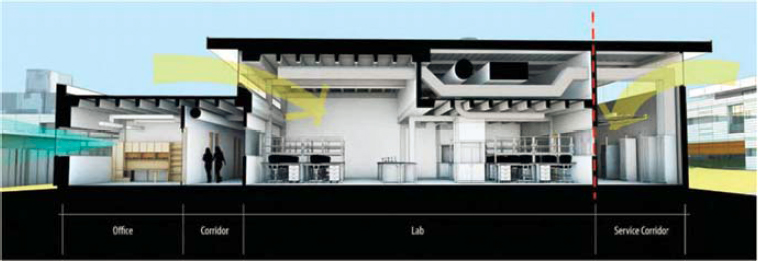
NOTE: Rendering from OFPM presentation.
SOURCE: OFPM, NIST.
___________________
4 This report uses “world-class” in the sense of being among the best in the world.
Decreased Downtime Improving Research Efficiencies
B1, Wing 3 Service Corridor Design
Renovations of Wings 3 and 6 have greatly improved the laboratory environment. One important feature of these renovations is the introduction of service corridors that enhance safety and utility (see Figure C-3). These corridors house laboratory utilities (electrical panel, heating, cooling, air handlers, humidity control, pressurized air, chilled water, filtration, and Internet) allowing maintenance to be conducted without entering the laboratory space or interrupting measurements. Each laboratory module has a separate set of utilities, with space for upgrade if additional power, heating, cooling, or air filtration is required for the specific work in that laboratory. The laboratory-side wall of the corridor is reserved for laboratory use, allowing researchers to place vacuum pumps, refrigerators, gas cylinders, and other support items safely outside the laboratory.
Impact: Recognizing the ever-increasing demands on measurement science research, NIST renovation designs seek to future-proof laboratory spaces by enabling modular upgrades to meet program requirements.
RESEARCH AND MEASUREMENT SERVICE ACTIVITIES ARE IMPAIRED IN OLDER NIST FACILITIES
Measurement science focuses on characterizing a property—the “measurand”—while minimizing the noise and fluctuation that deleteriously increase the uncertainty of the measurement. Obtaining the lowest uncertainties, thus improving precision and accuracy, requires a high degree of stability of the measurement instrumentation and the external environment that may influence the measurement. In general, this requires environmental stability so that the measurand of interest can be isolated and characterized without the influence of other factors. The older, unrenovated laboratories in Boulder create a host of challenges for measurement science researchers. Humidity control is nonexistent, temperature control is poor, and chilled water supplies often insufficient to support both room and instrument cooling. Many spaces are antiquated, with leaky windows, separate heat and cool systems, and shared thermostats that cause unintended temperatures in other spaces. There is no separate area for utilities, so electrical panels reside in the laboratory spaces. Many laboratories require processing tools and vacuum pump and closed cycle refrigerators raising the noise within laboratories to annoying levels.
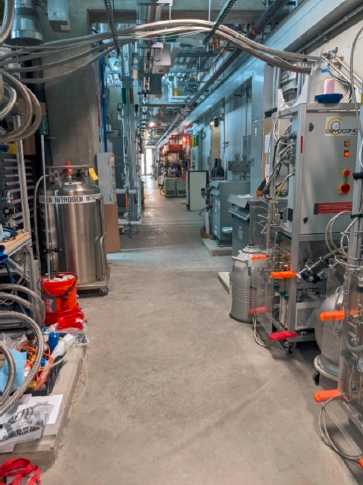
SOURCE: Public Affairs Office, NIST.
Examples of Negative Impacts on Research
Apart from the new and renovated spaces, the remainder of NIST-Boulder laboratories are housed in 1950- and 1960-era unrenovated facilities. These deteriorated buildings provide very poor temperature control, no humidity control, insufficient chilled water capacity, and in many cases, limited protection from outside dust and precipitation due to improperly sealed windows. Moreover, site-wide power blackouts, brownouts, and glitches severely limit progress on experiments and measurements that require long setup (alignment, tuning, and calibration) times or long data collection windows. The committee viewed several laboratory activities that were operating well below potential due to facilities issues.
Lost Productivity (approximately 15 percent) in Development of Energy-Saving Electronics
Magnetic Tunnel Junction devices (Building 24, Room 1212)
The NIST Spintronics program seeks to advance the use of electron-spin devices as a lower power substitute for semiconductor electronic memory. Magnetic tunnel junctions (MTJs) are nanostructured devices that are designed to harness spin electronic effects and form a basic building block for spintronics. This laboratory houses vacuum deposition equipment that is used to fabricate MTJs.
Due to its proximity to the building’s electrical transformers, the laboratory is electrically noisy; in situ or electrical measurements cannot be performed, and device characterization must be performed elsewhere. The 1967 laboratory is not protected from dirt or dust and particulates limit the density of devices that can be fabricated, which further limits the yield of devices per processing run as well as placing hard limits on the type of research that can be done.
Most problematically are site-wide power glitches that occur about 12 times per year. Each glitch typically requires 3 days of effort to restart equipment, pump down chambers, and reset the experiment, effectively wasting at least 15 percent of staff time. Glitches occasionally damage equipment, wasting more staff time as well as incurring replacement expense.
Impact: Poor physical facility condition and functionality squander at least 15 percent of PhD-level staff time focused on developing energy saving electronics, while also blocking areas of exploration due to limits on feature size.
Delayed Advances in Quantum Science
Microwave photonics (Building 1, Room 1-3333)
The same laboratory that won awards for quantum microresonators also includes quantum computing research. While this work greatly benefits from the wing 3 renovation completed in 2016, it is severely constrained by site-wide power glitches and interruptions that occur roughly every month. Because of the delicate and time-consuming calibration and state preparation required for these nascent quantum systems, 2 weeks of work is often required to reset the experiment after a power glitch. This can be mitigated if certain procedures are executed within minutes of a glitch, and staff report that it is common to sleep in the laboratory on nights when storms increase the probability of a power glitch.
Impact: Advances in quantum science, a United States strategic technology priority, are routinely frustrated by recurring power transients.
Millions of Dollars in Damage to Semiconductor Research Laboratory Delays Research for 1 Year
Nanoscale Reliability (Building 2, Rooms 1061 and 1075)
This laboratory, located in the oldest laboratory building on campus (built in 1951), performs research to understand, mitigate, and ideally eliminate defects that undermine the reliability of semiconductor devices,
additive manufacturing parts, and structural materials using electron microscopes capable of nanoscale resolutions optimized for such studies. This laboratory was instrumental in analyzing steel recovered from the World Trade Center buildings, as part of the NIST study that explained the causes of the structure’s collapse and subsequently developed improved building codes.
This work was interrupted by a roof leak that poured water into this unique equipment; the instrument was out of commission for 6 months for repairs. Initial repairs appeared successful, but undetected corrosion subsequently caused a fire in the high-voltage (220 kV) circuitry that drives the electron microscope. Overall, this facility’s failure caused a 12-month delay in work focused on improving interconnect reliability in ever-shrinking semiconductor electronic devices. In addition to lost work, the replacement cost for this electron microscope is estimated at $2.5 million.
Impact: A leak in a more than 20-year-old roof led to millions of dollars in direct economic losses due to damaged equipment and months of delays in research toward reliability of semiconductor devices and strategic technology for the United States.
Examples of Negative Impacts on Measurement Services
In addition to deleterious effects on research, the committee observed direct impacts on the NIST measurement services programs that disseminated NIST metrology capability to the U.S. government and industry. The committee viewed several measurement service activities that were seriously impeded by facilities issues.
Delays in Delivery of Unique Devices Needed for National Security
Quantum Sensor Laboratory (Building 1, Room 2114)
NIST has developed unique superconducting X-ray and gamma-ray spectrometers and bolometers, and these sensitive arrays are created under strict environmental control in the state-of-the-art Boulder Microfabrication Facility. These sensitive devices have applications in materials analysis or as telescope arrays for understanding the early universe through cosmic background radiation measurement. These sensors also have important security applications in nuclear materials identification and accounting. This NIST program fabricates and packages sensor spectrometer devices for critical national security needs, including deliveries to the Department of Energy’s Idaho National Laboratory where it will be used to measure nuclear fuels, and to Los Alamos National Laboratory where it will be used to measure trace samples for signatures of nuclear activity.
While the sensor arrays are fabricated in a clean room, wiring and packaging occurs in an unrenovated laboratory space. The laboratory has no humidity or dust control. The laboratory’s temperature control is provided by the 1950s building systems: cooling based on chilled water fan coil units (limited by chilled water capacity in wing 1) and heating from separate boiler-fed heat exchangers. To mitigate dust, researchers have inset curtained areas within the laboratory (see Figure C-4). Despite this precaution, several systems failed after packaging. These failures were traced to low humidity during the Colorado winter that increased electrostatic charge and damaged the devices despite the grounding precautions that were taken. After 3 months of lost time with unsuccessful fabrication and packaging, the laboratory was outfitted with home humidifiers, and devices were delivered to government agencies for use.
Impact: The development and delivery of novel devices with direct national security applications are delayed due to poor environmental conditions; deliveries resume only when technical staff modified conditions using household appliances.
Calibration Services Supporting Global Communications Off-line 10 Percent of the Time
Optical Fiber Power Calibration Laboratory (Building 1, Room 3074)
Optical fiber power meter calibration is one of NIST’s more popular services, accounting for about 5 percent of NIST calibrations, and is used by industrial laboratories around the world, as well as each of the Department of Defense’s (DoD’s) service’s calibration laboratories. This calibration supports the development and maintenance of the fiber optic systems through which all modern communications are transmitted. Without proper power levels, signals are lost to noise, become clipped and lose fidelity, or overpower and damage components. In addition, new detectors used in quantum systems, such as quantum key distribution for secure communications, are characterized in this laboratory.
The laboratory can support one calibration per day and the high demand requires that calibrations be performed almost every day. As a NIST calibration service, each measurement is documented with a certificate that includes the laboratory temperature and humidity. Unfortunately, this older laboratory has no humidity control and limited temperature control due to the 1950s building systems, and calibrations can only be performed when the laboratory temperature and humidity are within standard ranges. Staff noted that calibration runs are cancelled about two times per month because room temperature is out of range.
Impact: A high demand calibration service that underpins all global communications must go off-line about 10 percent of the time due to unacceptable temperature variations.
Gaps in Non-Laboratory Buildings
As shown in the Table C-4 below, much of NIST’s non-research staff are housed in “temporary” buildings including wood framed buildings used during the construction of the original campus and subsequent construction trailers that never removed but became office space when demand for research offices displaced the staff from Building 1.
The committee toured Building 91, a former construction trailer brought to the site in 2008, for the construction of Building 81. It is one of the newest temporary buildings and has one of the highest facility condition indexes amongst the non-laboratory buildings. The Office of Information Systems Management’s (OISM’s) local IT staff are housed in this construction trailer, which does not have a restroom or running water and is plagued with roof leaks. There were numerous rain catchment systems throughout the building channeling water leaks into buckets (see Figure C-5).
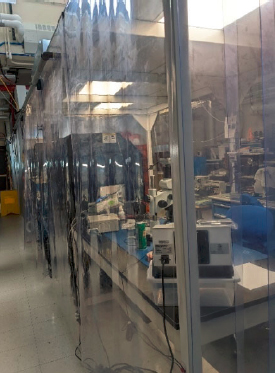
SOURCE: Public Affairs Office, NIST.
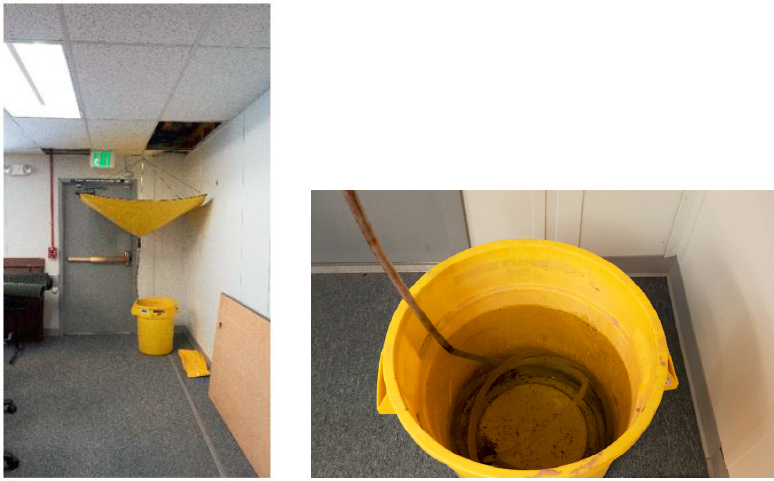
SOURCE: Public Affairs Office, NIST.
TABLE C-4 Non-Laboratory Buildings
| Buildings | Space Usage | Year of Constructiona | GSFb | FCIb |
|---|---|---|---|---|
| Building 3A | Office | 1989 (Temporary) | 2,160 | 61.71 |
| Building 4 | Office | 1951 (Temporary) | 15,795 | 48.63 |
| Building 5 | Offices | 1951 (Temporary) | 3,149 | 60.54 |
| Building 21 | Garage | 1963 | 3,999 | 45.35 |
| Building 25 | Maintenance Shops | 1966 | 8,830 | –35.26 |
| Building 91 | Offices | 2008 (Temporary) | 3,561 | 88.18 |
| Building 111 | Offices | 2011 (Temporary) | 2,821 | 44.30 |
| Building 112 | Maintenance/Storage | 2011 (Temporary) | 5,795 | 100 |
| Building 113 | Offices | 2013 (Temporary) | 1,440 | — |
a NIST Master Plan.
b FCI worksheet provided by OFPM.
The non-laboratory buildings are in very poor condition, as shown in the table below. They are scattered about the campus. The Master Plan recommends the demolition of this plethora of structures and the construction of a structure to consolidate the support staff into one location.
REFERENCES
Johnston, H. 2021. “Quantum Entanglement of Two Macroscopic Objects Is the Physics World 2021 Breakthrough of the Year.” https://physicsworld.com/a/quantum-entanglement-of-two-macroscopic-objects-is-the-physics-world-2021-breakthrough-of-the-year.
Lynch, M.K. 2020. “UK Catalysis Market Study Summary.” https://ktn-uk.org/wp-content/uploads/2021/08/KTN-Catalysis-Market-Study-Summary-26.06.20-MKL-Corrected-with-copyright-disclaimer-may21.pdf.
NIST (National Institute of Standards and Technology). 2006. “Report on NIST-Boulder Laboratory Facilities: Findings and Recommendations on Possible Renovation of Existing Facilities and Possible Construction of New Laboratory Facilities.” Boulder Facilities Review Team.
NIST. 2014. “Research Facilities Strategic Plan, Volume 2: Appendices.” Gaithersburg, MD.
NIST. 2017. “Department of Commerce Boulder Laboratories Campus Master Plan.” https://www.nist.gov/system/files/documents/2017/07/31/doc_boulder_mp_finalmasterplan_june2017_508compliant.pdf.













